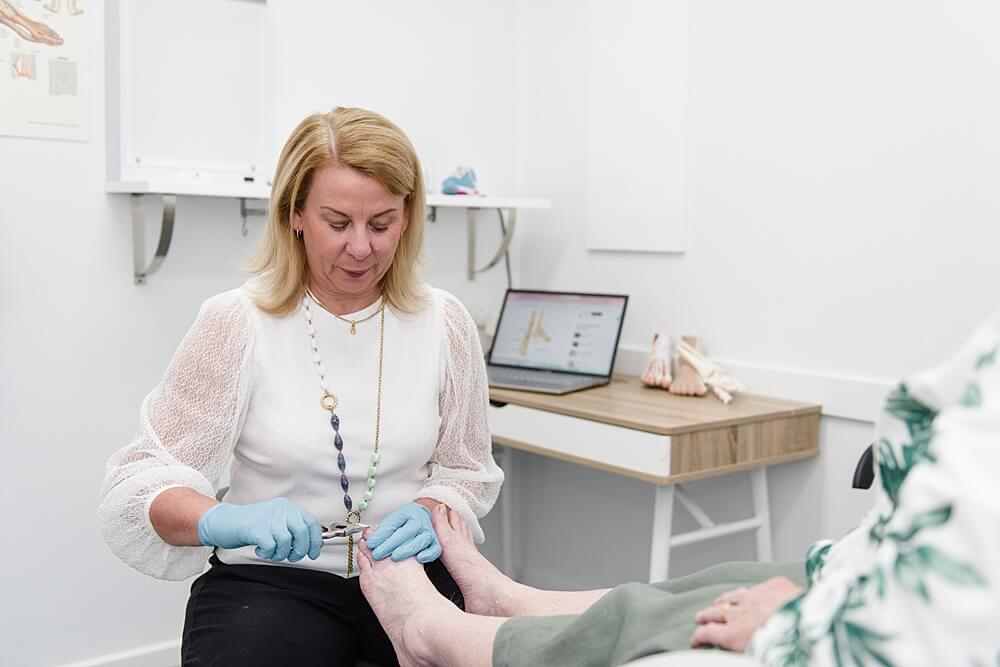Fungal Toenail Treatment Melbourne
Fungal nail infections, also known as onychomycosis, can affect one or more toenails and are caused by various types of fungi. If you suspect you have a fungal nail infection, it’s essential to seek a diagnosis and treatment from a podiatrist or a healthcare professional.
Here’s how you can determine if you have a fungal nail infection, how a podiatrist diagnoses it, and the treatment options available:

How do I know if I have a fungal nail infection?
Change in Nail Appearance: One of the most common signs is a noticeable change in the affected nail’s appearance. Look for:
- Thickening of the nail
- Discoloration, often yellow, brown, or white
- Brittleness or crumbling of the nail
- Distorted or irregular nail shape
- Dark debris under the nail
Nail Discomfort: Fungal nail infections can sometimes cause mild to moderate pain or discomfort, especially if the infection progresses.
Odor: A foul odor may be present due to the fungal infection.
Spread: Fungal infections can spread to other nails or to the surrounding skin if left untreated.
Diagnosis by a Podiatrist:
A podiatrist is a specialized healthcare professional who can diagnose and treat foot and nail conditions, including fungal nail infections. Here’s how they typically diagnose a fungal nail infection:
- Physical Examination: The podiatrist will start by examining the affected nail(s). They will look for characteristic signs and symptoms such as nail thickening, discoloration, and debris under the nail.
- Nail Scraping: In some cases, the podiatrist may take a small sample or scraping from the affected nail(s) to send to a laboratory for microscopic examination and fungal culture. This can confirm the presence of fungal infection and identify the specific type of fungus.
- Clinical Evaluation: The podiatrist will evaluate the overall health of your feet and assess whether there are any contributing factors, such as poor circulation, that may affect treatment options.
What are the treatment options for Fungal Toenails?
Treatment for fungal nail infections can vary depending on the severity of the infection and individual factors. Podiatrists typically offer the following fungal nail treatment options:
- Topical Antifungal Medications: Over-the-counter or prescription-strength antifungal nail creams, solutions, or nail lacquers may be recommended. These are applied directly to the affected nail(s) regularly for an extended period.
- Oral Antifungal Medications: In more severe cases or when topical treatments are not effective, oral antifungal medications prescribed by a podiatrist may be necessary. These medications are taken for several months and can help the new nail grow without infection.
- Fungal Nail Laser Therapy: Some podiatrists offer laser treatments that target the fungal infection in the nail. This approach is still relatively new and may require multiple sessions.
- Surgical Removal: In advanced cases, if the infection is causing severe pain or if there is a risk of spreading, a podiatrist may recommend the surgical removal of the infected nail. This allows for the application of antifungal medication directly to the nail bed.
- Preventive Measures: Podiatrists also provide guidance on preventive measures, such as proper foot hygiene, keeping feet dry, wearing breathable shoes, and avoiding walking barefoot in communal areas like public pools or locker rooms.
It’s important to note that fungal nail infections can be challenging to treat, and successful treatment often takes time and patience. Even after the infection is cleared, it may take several months for the healthy nail to grow in fully. To ensure the most effective treatment, consult with a podiatrist who can accurately diagnose the infection and provide personalized treatment options tailored to your specific needs and the severity of the condition. Early diagnosis and treatment can help prevent the infection from spreading and causing further complications.
How long does it take for the treatment to work?
The duration of treatment varies. It may take several months for the new, healthy nail to grow in and replace the infected nail. Consistent and proper application of prescribed medications is crucial.
Can I prevent fungal toenail infections?
Yes, practicing good foot hygiene, wearing breathable shoes, keeping feet dry, and avoiding walking barefoot in communal areas like locker rooms can help prevent fungal toenail infections.
Can fungal toenail infections go away on their own?
Fungal toenail infections are unlikely to resolve on their own. Without treatment, the infection may persist and potentially worsen over time. It’s recommended to seek professional advice for appropriate intervention.
Always Consult A Trained Professional
The information in this resource is general in nature and is only intended to provide a summary of the subject matter covered. It is not a substitute for medical advice and you should always consult a trained professional practising in the area of medicine in relation to any injury or condition. You use or rely on information in this resource at your own risk and no party involved in the production of this resource accepts any responsibility for the information contained within it or your use of that information.
